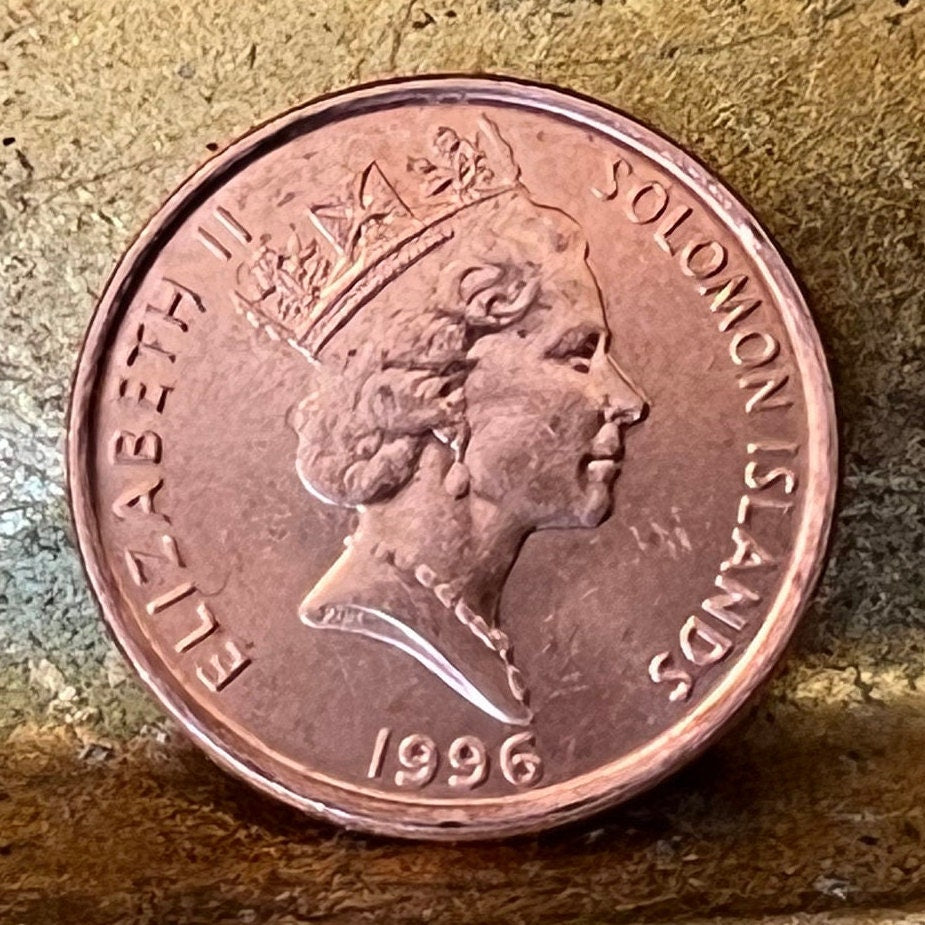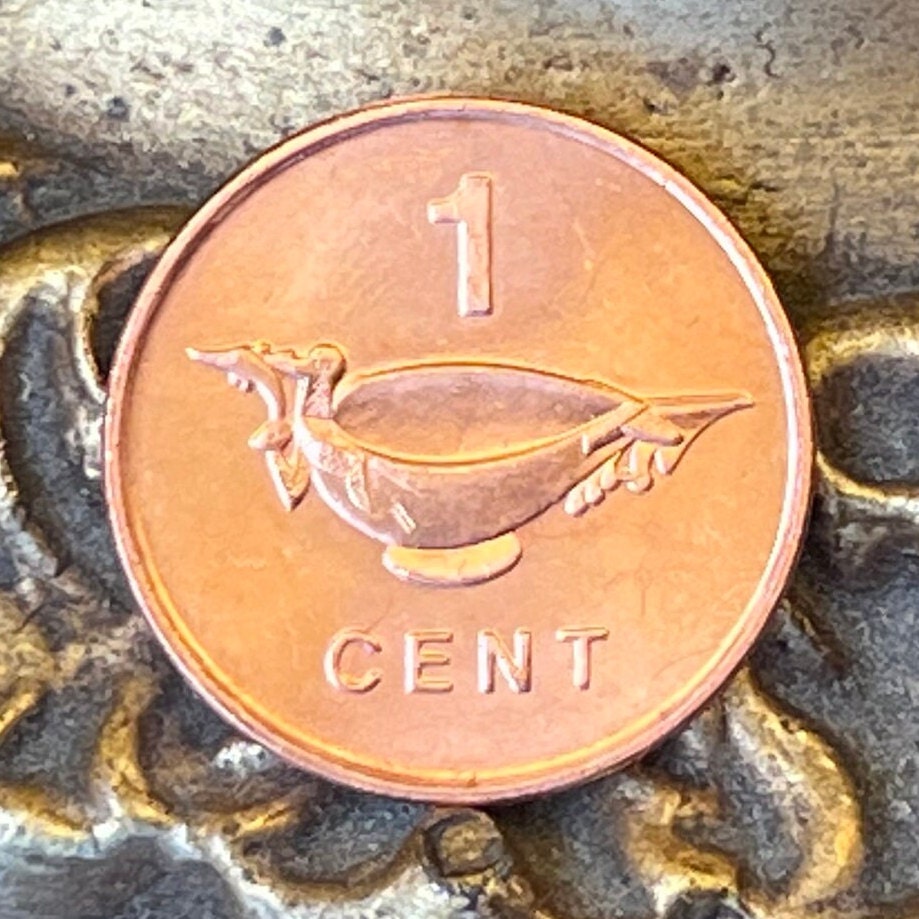elemintalshop
Frigatebird Catching Bonito Fish Carved Bowl 1 Cent Solomon Islands Authentic Coin Money for Jewelry and Craft Making (Bonito Fish Society)
Frigatebird Catching Bonito Fish Carved Bowl 1 Cent Solomon Islands Authentic Coin Money for Jewelry and Craft Making (Bonito Fish Society)
Couldn't load pickup availability
Frigatebird Catching Bonito Fish Carved Bowl 1 Cent Solomon Islands Authentic Coin Money for Jewelry and Craft Making (Bonito Fish Society)
Obverse: Queen Elizabeth II.
Lettering: ELIZABETH II SOLOMON ISLANDS
(Wikipedia: Solomon Islands is a constitutional monarchy and has a parliamentary system of government. As Queen of Solomon Islands, Elizabeth II is head of state; she is represented by the Governor-General who is chosen by the Parliament for a five-year term.)
Reverse: Frigatebird-shaped ceremonial bowl.
Lettering: 1 CENT
Features
Issuer Solomon Islands
Queen Elizabeth II (1952-date)
Type Standard circulation coin
Years 1987-2010
Value 1 Cent (0.01 SBD)
Currency Dollar (1977-date)
Composition Bronze plated steel
Weight 2.3 g
Diameter 17.53 mm
Thickness 1.8 mm
Shape Round
Technique Milled
Orientation Medal alignment ↑↑
Demonetized Yes
Number N# 3482
References KM# 24
Ceremonial bowls were important ritual objects used during the initiation ceremonies of the bonito fish society, a high-ranking group of men and boys in the community. The bowls were filled with food and offered up to the spirits as part of the initiation. Many vessels like this one are carved in the form of a frigatebird. Native to the Solomon Islands, the frigate-bird not only embodied many valued characteristics such as agility and speed, it was also admired for its fierce and aggressive hunting skills as well as its ability to find schools of sacred bonito fish.
Source: https://coin-brothers.com/catalog/coin6236
*****
Wikipedia:
Frigatebirds (also listed as "frigate bird", "frigate-bird", "frigate", "frigate-petrel") are a family of seabirds called Fregatidae which are found across all tropical and subtropical oceans. The five extant species are classified in a single genus, Fregata. All have predominantly black plumage, long, deeply forked tails and long hooked bills. Females have white underbellies and males have a distinctive red gular pouch, which they inflate during the breeding season to attract females. Their wings are long and pointed and can span up to 2.3 metres (7.5 ft), the largest wing area to body weight ratio of any bird.
Able to soar for weeks on wind currents, frigatebirds spend most of the day in flight hunting for food, and roost on trees or cliffs at night. Their main prey are fish and squid, caught when chased to the water surface by large predators such as tuna. Frigatebirds are referred to as kleptoparasites as they occasionally rob other seabirds for food, and are known to snatch seabird chicks from the nest. Seasonally monogamous, frigatebirds nest colonially. A rough nest is constructed in low trees or on the ground on remote islands. A single egg is laid each breeding season. The duration of parental care is among the longest of any bird species; frigatebirds are only able to breed every other year.
*****
The Maraufo: An initiation rite of the Eastern Solomons.
Posted on March 19, 2014
Source for below article: http://www.tribalartbrokers.net/praisetribal/index.php/the-maraufo-an-initiation-rite-of-the-eastern-solomons/
The bonito, a member of the tuna family, is common in Oceania and highly valued as a food fish. It is eagerly fished for throughout Polynesia and in areas of Micronesia and Melanesia, including the Solomon Islands.
In the South East Solomon Islands, however, the bonito was elevated from a food source to become the focus a religious cult that dominated men’s lives. This cult existed within the triangle formed by three specks of land Santa Ana (Owa-raha) and Santa Catalina (Owa-riki), two small islands opposite the south-east peninsula of the larger island of San Cristoval (Makira), which was the third point.
The Bonito used to migrate through this area annually in large numbers, pursuing vast schools of small bait fish varieties such as pilchards.
During this annual migration, the bait fish were sometimes chased close to the surface and the water surface boiled with bait fish, bonito, sharks and sea birds. The natives, who regarded bonito as human beings of the sea because they had no visible scales and red blood, believed this annual visitation to be a gift from the gods and proof of their benevolence and a cult grew around the need to placate the gods to ensure a plentiful harvest of fish
A complex ritual grew up around this annual event. As the bonito fishing season drew near, presentations of food were made to the gods through the local shaman or priest, who had an altar for this purpose in the canoe house. Strict taboos were enforced and the first bonito caught each season was ritually dedicated to the gods. On the rare occasions when the bonito did not make their annual appearance, this was blamed on the breach of a taboo by a member of the community. (Women, for example, were forbidden to touch the bonito canoes or even approach the canoe house).
The presence of a bonito school in the area was usually pinpointed by observing the large flocks of predatory birds that followed it – watching either from land or from a canoe waiting at sea. Once located, the bonito were approached in fast fishing canoes called againiwaiau, light enough to be carried by two men, which paddled into the mass of bonito, sharks and birds to capture as many as bonito possible using long bamboo rods and composite hooks made of mother of pearl and turtle shell that spun like a bait fish in the water.
The function of the Maraufo rituals was to initiate older boys into manhood by passing on the secret knowledge required to manage the tripartite relationship between the gods, the bonito fish and humankind during a period of seclusion that lasted several months.
To begin the maraufo rituals, a boy candidate had to be paddled out to the bonito school in a canoe and allowed to touch the rod while a bonito was landed . On his return to the canoe house, he would be blooded by his first bonito catch, hugging it to his body and even drinking its blood. From this point onwards, he became a maraufo boy, and lived in seclusion in the canoe house for several months, separated from his family and able to eat only a limited number of foods.
At the climax of the maraufo , the boys who had been transformed into men by the blood of the bonito and their months of seclusion paraded on a specially built qua or display platform in all their impressive finery, each carrying a woven bag of presents to be thrown to the cheering crowd below and a lightweight replica of the distinctive prow of an againiwaiau bonito fishing canoe to symbolise the capture of their first fish. They could then be reunited with their families and the period of seclusion ended.
Finally, at the end of this special day, the newly initiated young men entered into a symbolic marriage, presenting their canoe stern posts and combs to a young “bride” to signify that they were now old enough to court and marry,
Judith Woods, who witnessed the climax of a maraufo ceremony in Star Harbour, San Cristoval in September 1973, has vivid memories of the young men in all their finery, carrying bags of gifts and model canoe stern posts onto the display platform, which was a large open structure crowned with two life size bonito fishing canoes.
Share










I liked the fish bowl.
The coin was received as described









